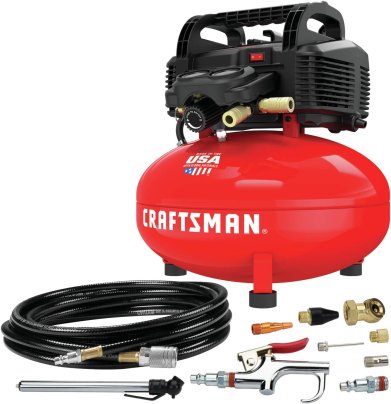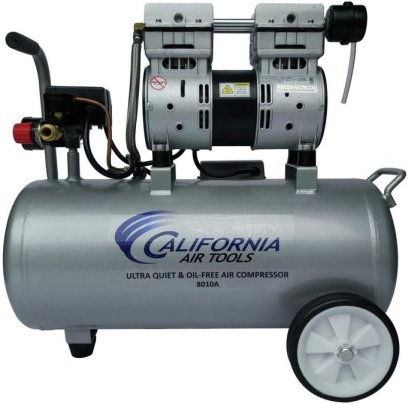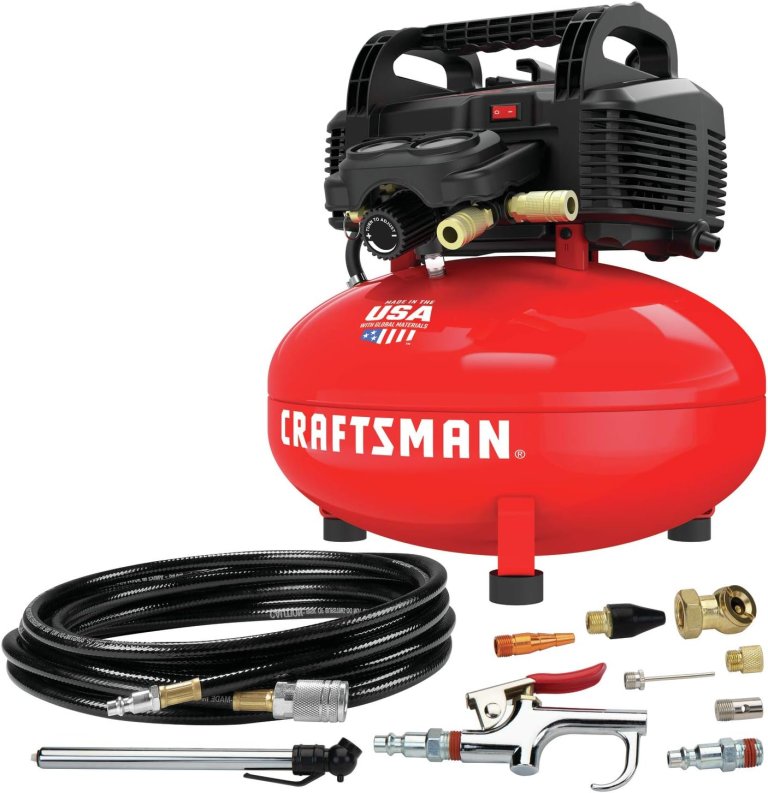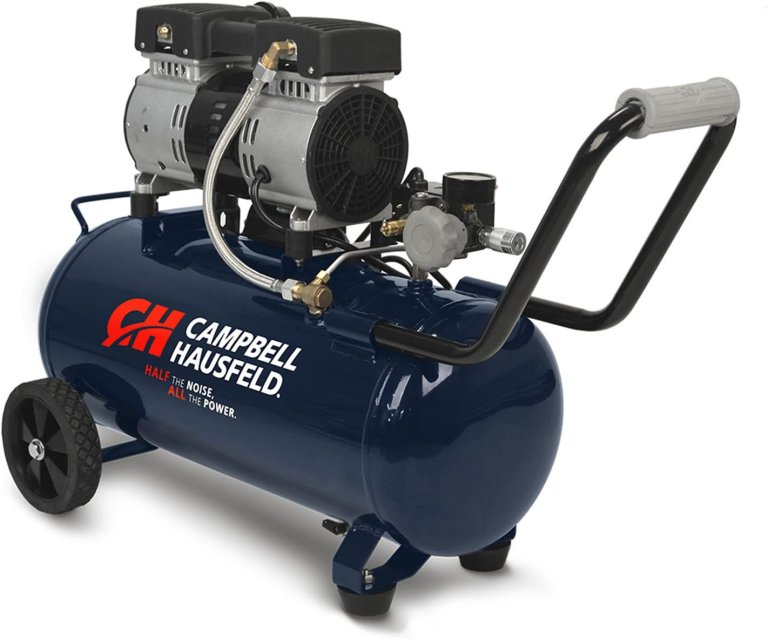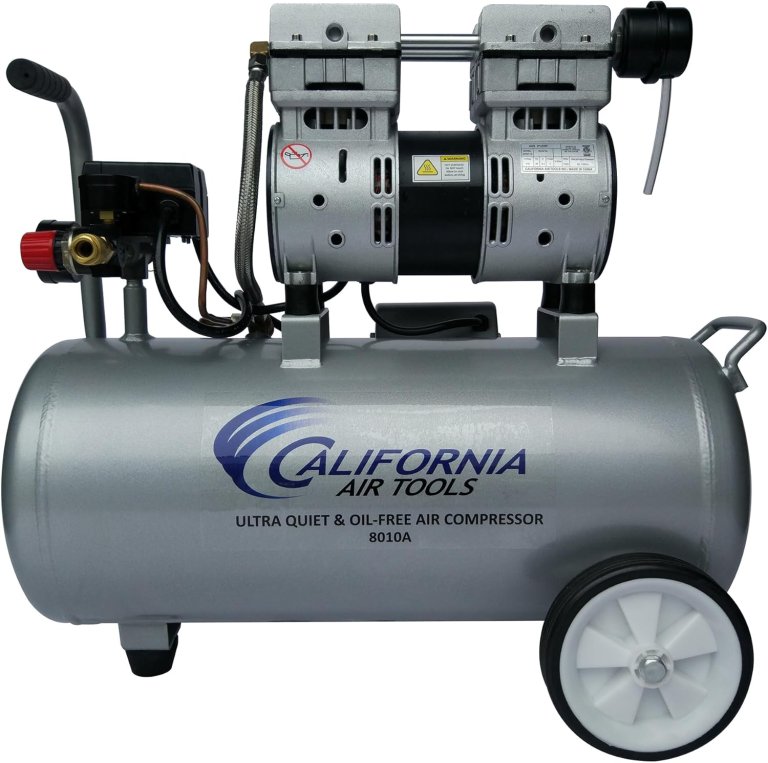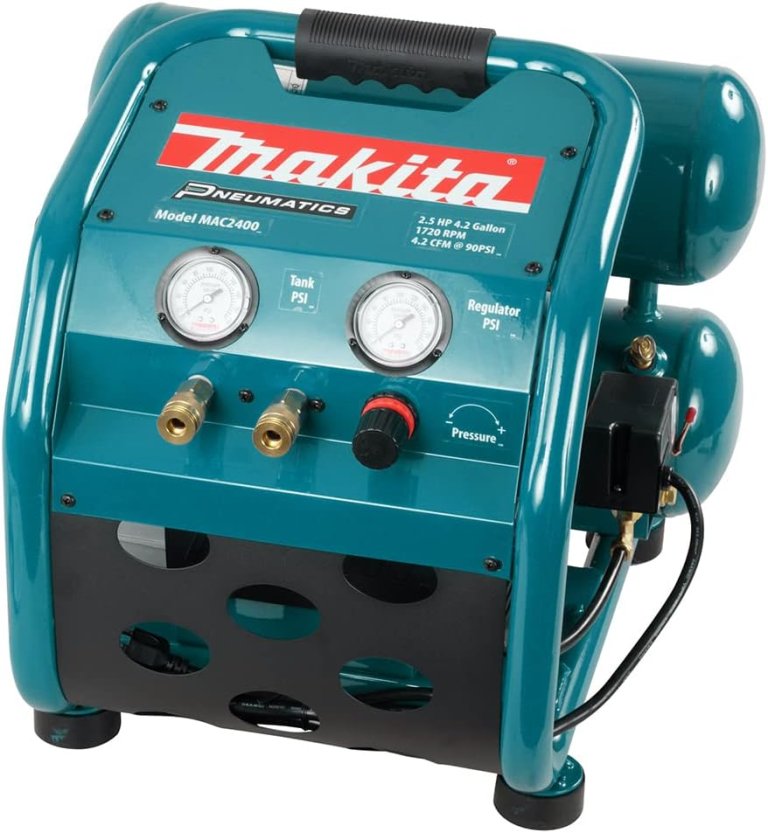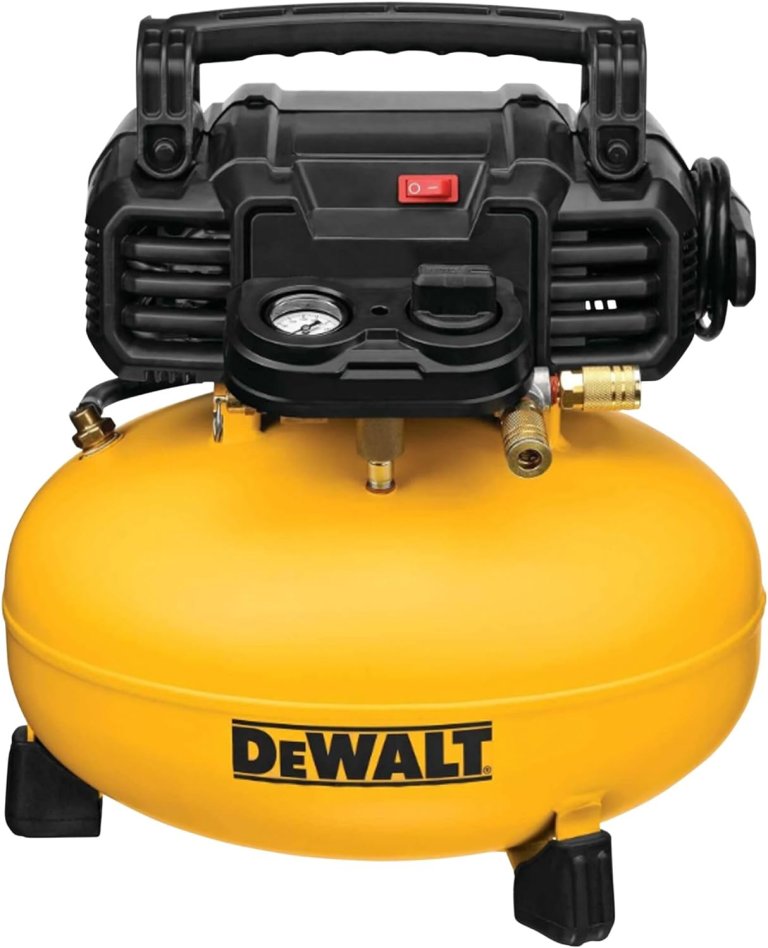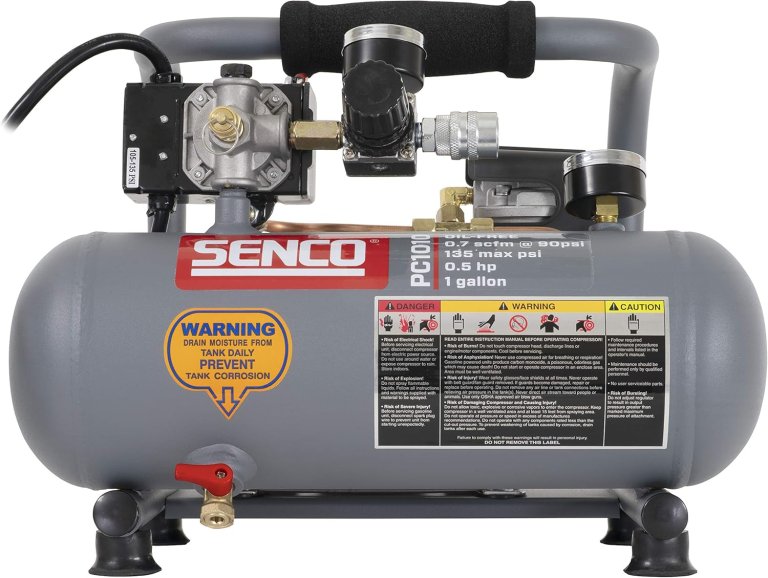We may earn revenue from the products available on this page and participate in affiliate programs. Learn more ›
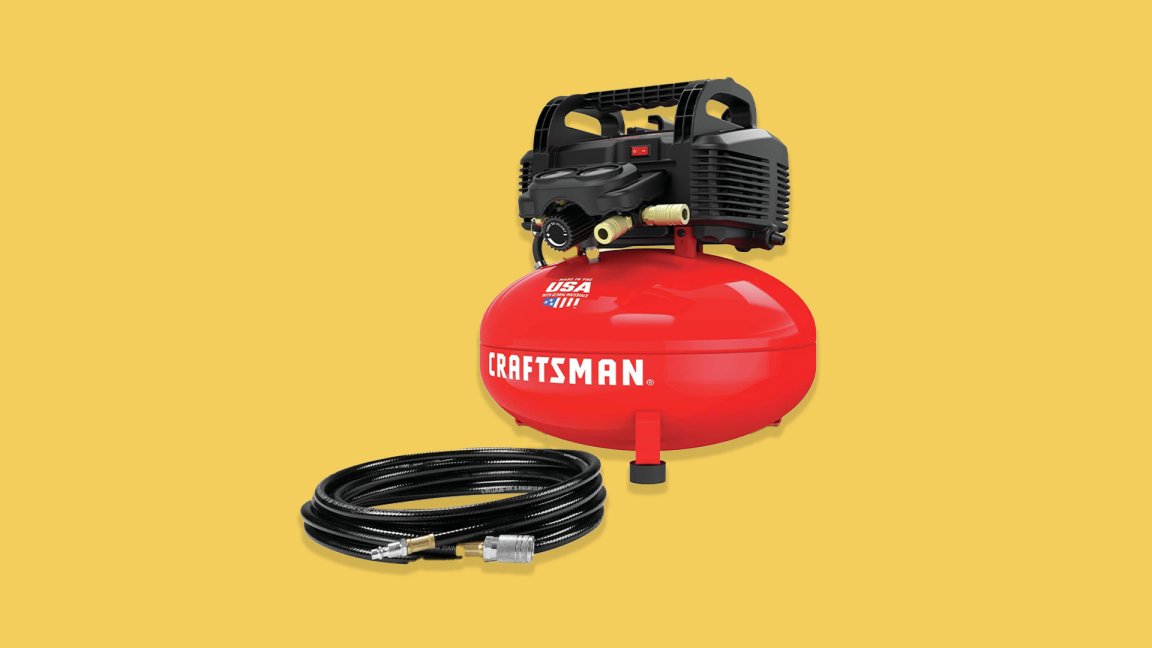
Battery-powered tools still haven’t taken over every job, so many professionals and hobbyists still rely on pneumatic tools for all sorts of jobs. If your work comes to you, chances are you have a nice, big air compressor somewhere in your shop to power these tools. But what if it doesn’t? Carpenters, roofers, and many other workers move from job site to job site, and their air compressors will need to follow.
Small air compressors make it possible for these folks to power their pneumatic tools no matter where they go. Hobbyists and DIYers may also rely on small air compressors to perform various projects and repairs. There are different types of small compressors on the market to service a range of needs. Be sure to find the right compressor to fit your specific needs.
Summary List
- Best Overall: Craftsman CMEC6150K 6-Gallon Air Compressor
- Best Value: Campbell Hausfeld 8 Gallon Portable Quiet Air Compressor
- Honorable Mention: California Air Tools 8010A Ultra Quiet & Oil-Free 1.0 HP Air Compressor
- Honorable Mention: Makita MAC2400 Big Bore 2.5 HP Air Compressor
- Honorable Mention: DeWalt DWFP55126 Pancake Air Compressor
- Honorable Mention: Senco PC1010 1-Gallon Compressor
Our Methodology
We came up with this list of best small air compressors by finding the best handful of models with the best mix of features, durability, weight/size, and pressure output, and weighed them against the prices they command. All of these are solid options depending on your chosen method of pressuring O-2. We also factored in a hearty amount of user feedback, and are proud of our thorough research. For more on our methodology, take a peek at this.
Best Small Air Compressor Reviews & Recommendations
Best Overall: Craftsman CMEC6150K 6-Gallon Air Compressor
Pros
- Included accessory package
- Great output
- Good weight/size
- Durable
Cons
- Might be a bit noisy to some
Looking to pick up a great small air compressor without any fuss and frustration? This American-made unit generates a maximum of 150 PSI and 2.6 SCFM at 90 PSI. Thanks to its durable, oil-free pump, this unit requires no maintenance while delivering long-term reliability. This small air compressor starts up easily in cold weather, and the dual couplers allow users to attach multiple hose and tool combinations for increased workspace efficiency.
Best Value: Campbell Hausfeld 8 Gallon Portable Quiet Air Compressor
Pros
- Oil-less, so it’s maintenance-free
- Comprehensive accessory kit
- Very quiet
Cons
- Expensive
- Heavy
For many jobs all over the house and garage, size and portability outweigh the demand for industrial-level performance. The Campbell Hausfeld 8 Gallon Portable Quiet Air Compressor sports an eight-gallon tank makes it easy to roll around the house or shop. Rated at a maximum of 125 PSI, this tank is perfect for a bunch of different CFM-demanding jobs. This air compressor is an oil-less, maintenance-free unit, and when the job is finished, this unit will fire right up for the next.
Honorable Mention: California Air Tools 8010A Ultra Quiet & Oil-Free 1.0 HP Air Compressor
Pros
- Excellent overall construction and quality
- Quiet
- Good pressure output
Cons
- Expensive
- Dimensionally big
Noise is an issue with most air compressors, yet this model manages to bring things down to an impressive 60 decibels. This unit is extremely lightweight for its size, weighing in at only 37.25 pounds, and this wheeled unit includes built-in handles to make this an extremely portable compressor. This unit boasts an eight-gallon, vertically oriented air tank with a maximum pressure rating of 120 PSI. Thanks to its aluminum construction, the tank is entirely rust-resistant, and the low-RPM, dual-piston motor generates strong performance at low decibel levels, providing 2.2 CFM at 90 PSI. The California Air Tools 8010A Ultra Quiet and Oil-Free 1.0 HP Air Compressor’s efficient design reduces power consumption, wear, and maintenance.
Honorable Mention: Makita MAC2400 Big Bore 2.5 HP Air Compressor
Pros
- Excellent flow and pressure
- Durable
- Good size
Cons
- Expensive
- Added complexity and weight of filtration system
The Makita Air Compressor is an impressive unit for its size, delivering significant capability. This air compressor features a 4.2-gallon twin-tank system capable of providing a consistent 130 PSI. The 2.5 horsepower engine helps deliver a whopping 4.2 CFM at 90 PSI but does so at lower RPMs to minimize noise, and its maximum PSI rating allows users to run two pneumatic tools at once. The compressor’s low-amp draw reduces the potential of tripping circuit breakers upon startup, and the cast iron, big bore cylinder offers fast recovery, improving durability and system performance. The Makita Air Compressor also features a protective roll cage that doubles as a carrying handle for easy portability.
Honorable Mention: DeWalt DWFP55126 Pancake Air Compressor
Pros
- Maintenance-free operation
- Works well in cold weather
- Good PSI
Cons
- While quieter dB than other options, still quite loud
More PSI means more run time for tools between cycles. The DeWalt Air Compressor has a six-gallon tank with a 165-PSI max rating and combines fast recovery and extended run time for improved productivity. The high-flow regulator and dual couplers increase pneumatic tool combinations and efficiency, and with a 75.5-decibel sound rating, this oil-free compressor is a little easier on the ears. Thanks to its pancake-style design, this unit is very stable during use, and at just 30 pounds, it is exceptionally portable. The high-efficiency motor starts quickly and easily in cold weather, even when connected to an extension cord. The DeWalt Air Compressor generates 2.6 SCFM at 90 PSI, but at 40 PSI, it bumps things up to 3.7 SCFM.
Honorable Mention: Senco PC1010 1-Gallon Compressor
Pros
- Super portable
- Great price
Cons
- Low CFMs mean it’s only good for minor jobs or inflating tires
The Senco PC1010 1-Gallon Compressor creates excellent power without destroying eardrums or back accounts. This offering from Senco provides users with a one-gallon air tank rated to contain a maximum pressure of 120 PSI, and the oil-less motor generates 1.4 SCFM, perfect for smaller jobs in the house or the workshop. The engine runs at 1/2 horsepower while capable of a full horsepower peak output, and during use, it creates low noise levels for a pleasant working environment. Weighing in at a featherweight 20 pounds and featuring a roll cage with a conveniently-located handle, this compressor is the epitome of AC-powered portability.
Our Verdict
Small air compressors are a compromise between size and capability. For most people, the Craftsman CMEC6150K 6-Gallon Air Compressor is an excellent option with its combination of power, stability, and reasonable noise output. When the price is a critical factor, buyers should consider the Campbell Hausfeld FP209499AV Portable Air Compressor instead.
What are key features of small air compressors?
Power and Efficiency: Air compressor power and efficiency are measured in horsepower, PSI, and CFM. Horsepower measures motor power, indicating how quickly it will refill a tank or generate air pressure. PSI indicates the amount of pressure a full air tank will contain, and CFM means how much air in terms of volume can flow through the outlet nozzle and hose. For maximum capability and value, be sure to prioritize CFM first and horsepower last.
Air Tank Capacity: Most air compressors use an air tank to store compressed air. Once this store is depleted, the motor kicks on to begin restoring pressure. The air tank’s capacity, combined with its flow rate (CFM), allows users to gauge how long a single tank will last between refills. The larger the capacity (measured in gallons) and the lower the flow rate, the longer the tank will last. As a rule of thumb, larger tanks are better.
Flow Rate: Before taking the air compressor plunge, buyers should understand the flow rate, which usually is measured in cubic feet per minute (CFM) or standard CFM (SCFM). CFM measures the amount of air that leaves a compressor in one minute when the air tank has a specified pressure, usually 90 PSI. SCFM measures CFM within certain environmental conditions. While similar, CFM and SCFM are not identical and should never be compared against each other.
What are the different types of small air compressors?
AC-Powered: Most small (and large) air compressors are powered via alternating current (AC) electricity. As such, these units require a standard 120-volt power outlet to operate. This makes them an excellent choice for garage and workshop use. Whether for light-duty jobs or hobby work, these units will accommodate just about every civilized setup.
Battery-Powered: While most small air compressors rely on AC power, a select few run off of battery power. While some are rechargeable, many of these units use car batteries to generate air pressure. While these units are intended primarily to help off-roaders inflate their tires on the trail, they can be adapted for other uses as well, albeit with a more limited capacity.
FAQs
You’ve got questions. The Drive has answers.
An oil-less compressor with a five-gallon air tank is often more than enough for most home-based users.
A: Under $100: Units in this price range are battery-powered and are designed mainly for tire inflation.
$100 and up: The vast majority of these units run off of AC power and are more powerful and versatile than their battery-powered brethren.
For most users, an oil-less air compressor will be an excellent choice. While these units generate lower CFM and PSI ratings than the oil-lubed counterparts, they are more efficient and require very little maintenance. However, for users seeking higher pressures and output, an oil compressor will be a better fit.
Air compressors with larger tanks and higher CFM ratings work better as they require less frequent tank refills while delivering significant power. If possible, use a compressor that can generate more CFM/SCFM than the tool’s listed rating, keeping in mind that CFM and SCFM are not equivalent measurements.
The piston orientation within an air compressor’s motor affects the unit’s overall footprint but not its power. Instead, consider the number of the piston in a motor. Single-piston (or single-stage) motors are less energy-efficient than their two-piston counterparts, while dual-stage motors can produce somewhat higher pressures with greater efficiency.
